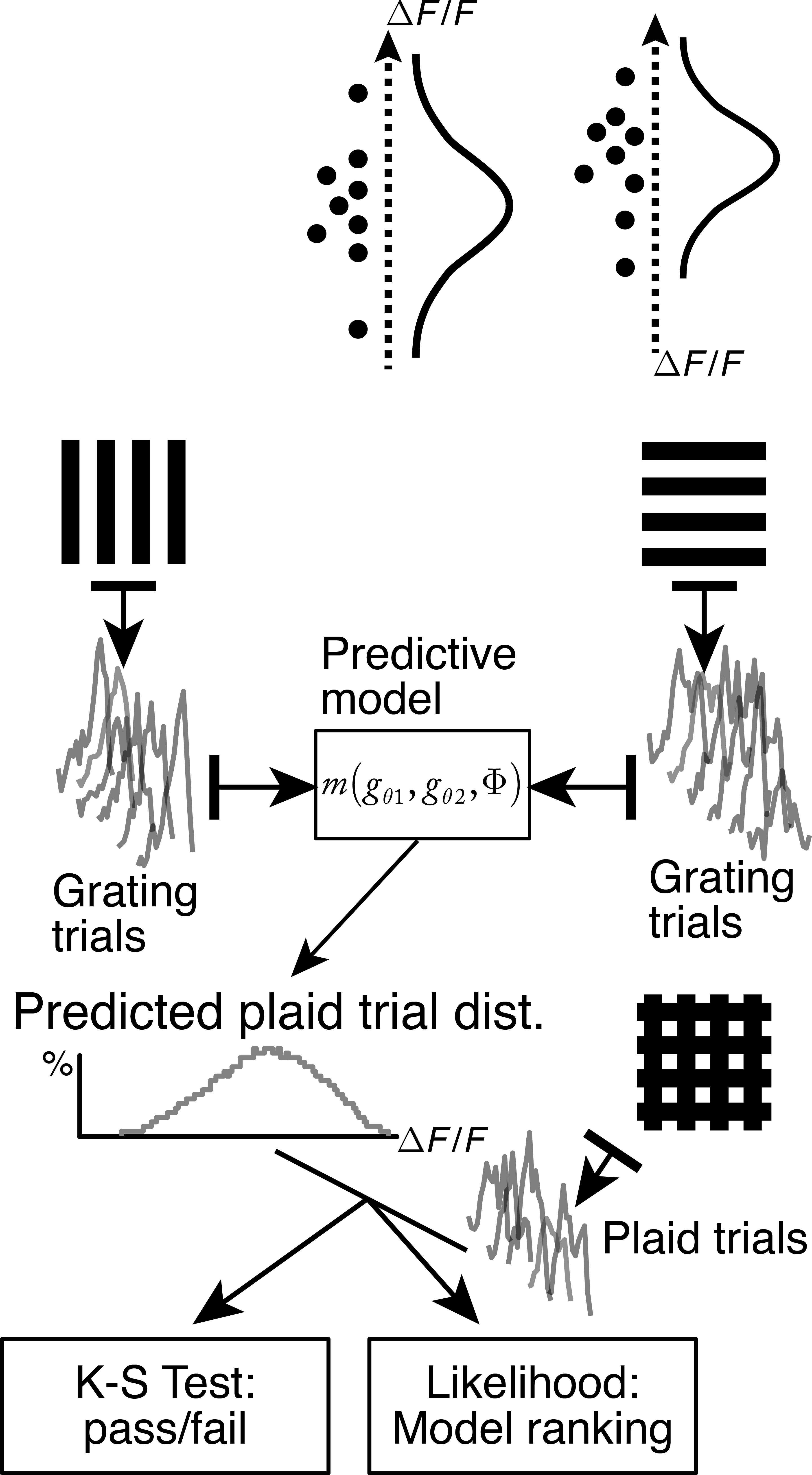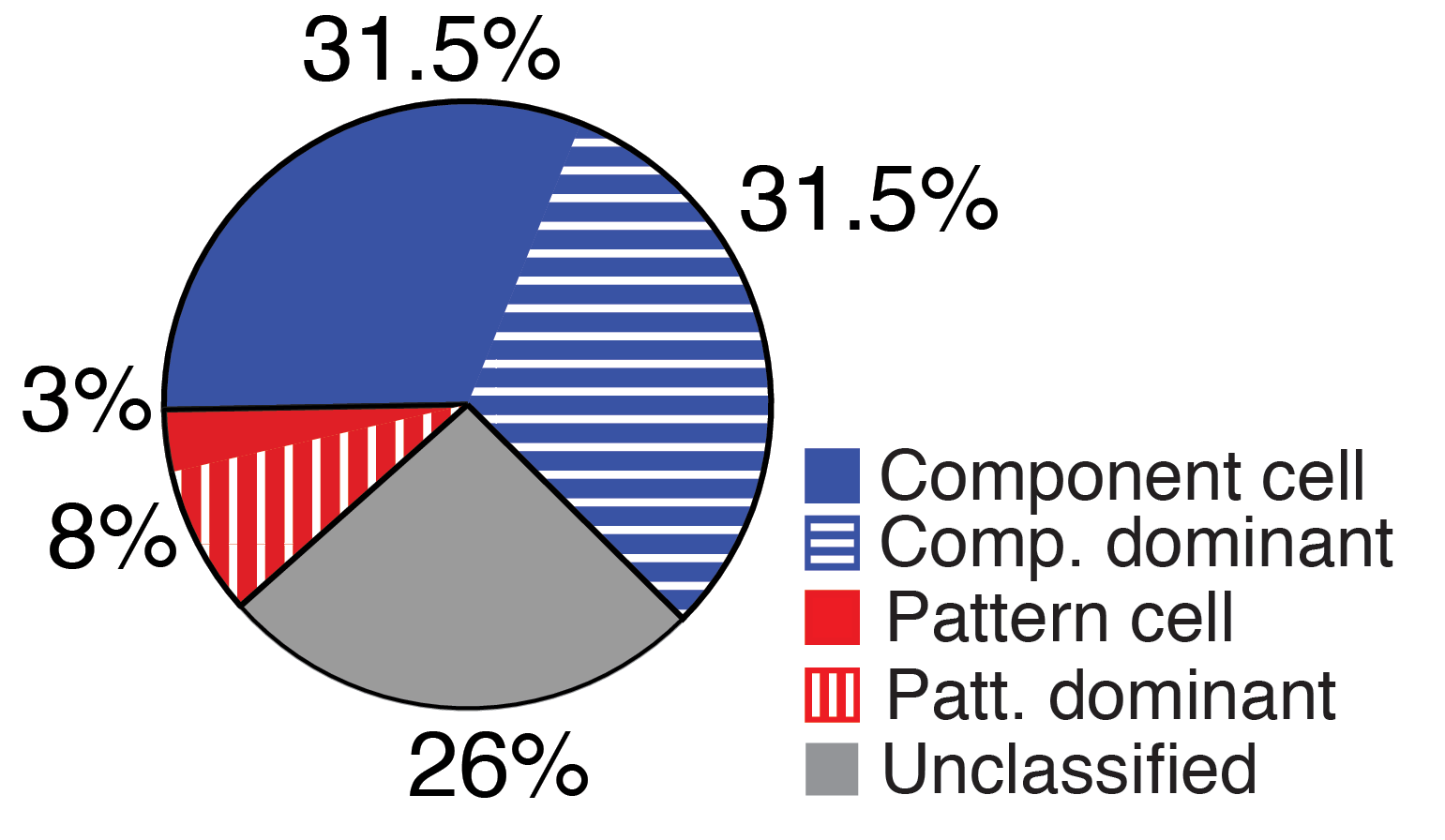Pattern motion responses in mouse visual cortex
Model-based analysis of cortical responses
8th August, 2015Example imaging region in mouse V1

Example imaging region in mouse V1
Figure 1: Model-based analysis framework

Figure 1: Model-based analysis framework
Figure 2: Proportions of pattern integration classes in mouse V1

Figure 2: Proportions of pattern integration classes in mouse V1
In visual cortex, information about features such as edges or textures with particular orientations must be integrated to recognize a visual scene or object. In principle, the architecture of rodent cortex would enable local circuits to integrate sensory information — however, whether feature integration occurs in rodent primary sensory areas has not been examined directly. Our results show that a broad range of pattern integration already takes place at the level of V1.
We studied local integration of sensory features in primary visual cortex (V1) of the mouse by presenting drifting grating and plaid stimuli, while recording the activity of neuronal populations with two-photon calcium imaging. Using a Bayesian model-based analysis framework, we classified single-cell responses as being selective for either individual grating components or for moving plaid patterns. Rather than relying on trial-averaged responses, our model-based framework takes into account single-trial responses.
Introduction
To study motion integration in visual cortex, plaid stimuli have been extensively used, where two differently oriented gratings are superimposed leading to the percept of a moving plaid (Zeki, 1974; Movshon et al., 1983). In monkeys, the classical view is that cells in primary visual cortex (V1) are selective primarily to the movement of individual oriented components, and are therefore classified as component-selective neurons. In contrast, pattern-selective cells, which respond to the overall motion of a plaid, are found more often in the specialized higher cortical area MT (Movshon et al., 1983; Rodman and Albright, 1989; Stoner and Albright, 1992), explained by feedforward integration of V1 responses within MT (Simoncelli and Heeger, 1998; Rust et al., 2006).
We asked whether pattern integration might already occur in V1. We used two-photon calcium imaging of neuronal populations in mouse V1 during presentation of moving gratings and plaid patterns to reveal the level of feature integration at this stage of the visual pathway. We used traditionally defined models for classifying component and pattern cells (Movshon et al., 1983) under a novel Bayesian framework that explicitly incorporates trial-to-trial variability in the analysis.
Imaging and model-based analysis
All animal procedures were carried out according to the guidelines of the University of Zurich, and were approved by the Cantonal Veterinary Office. Two-photon calcium imaging of neuronal responses upon visual stimulation was performed in mouse V1, using the calcium indicator OGB. Drifting square wave gratings of four orientations, and plaids formed of orthogonal gratings at 50% contrast, were presented to anaesthetised mice.
To classify the responses of neurons we used a novel Bayesian model-based analysis framework (Figure 1). Single-trial responses to grating stimuli are used to form a prediction of the response to a plaid stimulus under either a “component” or a “pattern” model. This prediction is then compared with the set of experimentally obtained single-trial responses to plaid stimuli. The framework provides a pass/fail test for each model, and the likelihood of observing the experimentally obtained responses is estimated in order to rank a set of models.
Pattern motion selective responses in mouse V1
We found a broad spectrum of neuronal responses ranging from neurons responding only to gratings to neurons with complex grating and plaid responses, as well as neurons that were only activated by plaid patterns (Figure 2). Of responsive and selective neurons in mouse V1, 31.5% showed component-like responses and 3% showed pattern-like responses. However, a large number of neurons showed strongly suppressive or facilitatory responses; the responses of these neurons was dominated heavily by one of the two stimulus classes. We found 31.5% component-dominant neurons and 8% pattern-dominant cells in mouse V1.
Our model-based classification procedure accounted for more than 70% of the responsive and selective neurons in mouse V1, and outperformed Partial Correlation analysis (which could only account for 20% of cells). Our new model-based classification method provides several advantages over previous techniques:
- We use single-trial responses to form predictions, rather than relying only on averaged responses. This implies that a successful model must not only explain the mean response to a stimulus but also match the distribution of single-trial responses.
- Any arbitrary number of models can be compared, using a rigorous statistical ranking based on likelihoods.
- Models can be rejected outright when their predictions are poor.
- We can therefore distinguish between models that make similar, ambiguous predictions for a cell; versus cells for which all models make poor predictions.
A final quarter of selectively responding neurons had complex responses that could not be explained by any simple integration model. Our results show that a broad range of pattern integration processes already take place at the level of V1. This diversity of integration is consistent with processing of visual inputs by local sub-networks within V1 that are tuned to combinations of sensory features (Kampa et al. 2006).
Publications
This work was published in Frontiers in Neural Circuits: DR Muir, MM Roth, F Helmchen and BM Kampa. 2015. Model-based analysis of pattern motion processing in mouse primary visual cortex, Front. Neural Circuits 9 (38). DOI: 10.3389/fncir.2015.00038.
Funding
This work was supported by the Swiss National Science Foundation (Grant Nr. 31-120480 to BK), the EU-FP7 program (BrainScales project 269921 to BK and FH), the University of Zurich (Forschungskredit grants to BK and MR), the Novartis Foundation (grants to BK and DM) and the Velux Foundation (fellowship to DM).